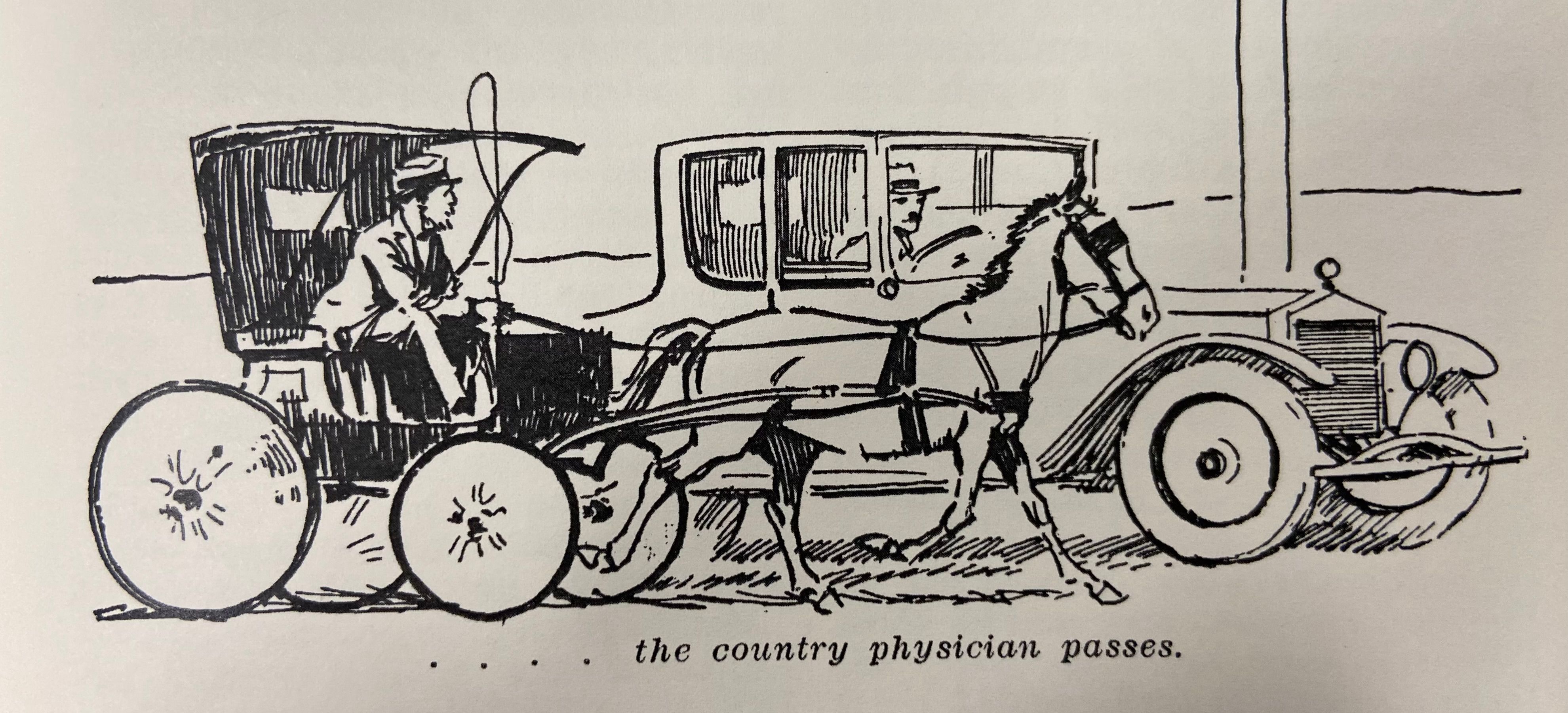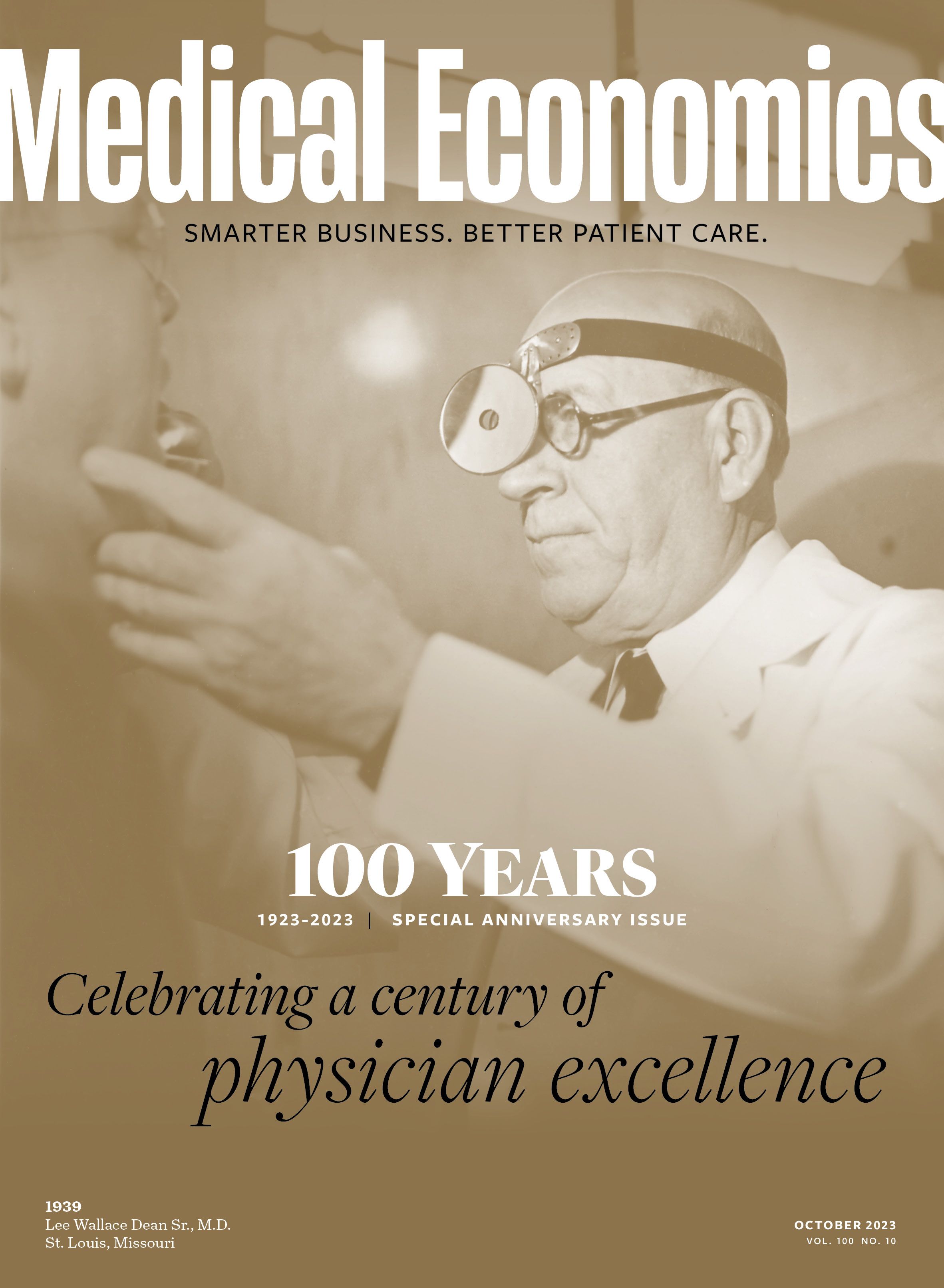Article
Medical Economics 100th Anniversary: Physicians were worried about rural healthcare, even 100 years ago
An article in the first issue of Medical Economics in 1923 worries about the plight of the rural physician.

Editor's note: This article appeared in the first issue of Medical Economics in October 1923. It is being republished in celebration of our 100th anniversary.
On his way to the limbo of the things that were, they tell us, the country physician passes. Unless there is an up slant in the curve, surely he is bound to the Land of Nepenthe.
If Dobbin ceases to draw the one-horse shay; if all the Dr. Lavenders leave Old Chester, and every Bonnie Briar Bush loses its Dr. Weelum McClure, what shall the country do? If the honest rural doctor sings his swan song, can the quack be far behind? Already charlatans are seeking the deserted practices. Healers with their jargon of Eddyism, disciples of Coué, bone twisters, muscle mangers and Ismpaths are not losing time.
Our sovereign states cannot permit millions of human beings to go without medical service, merely because they live in the bush. For that matter, neither can the nation. Shall we surrender to paternalism or will America’s citizens and the medical profession itself find the solution of this vexed economics problem? As the equation is complex, MEDICAL ECONOMICS first presents a fact story and then invites its readers to consider certain conclusions.
The future of the physician in the rural regions is fraught with such vital interest to the practitioners still there, and to recent medical graduates seeking places, that every element of it is worthy of analysis. If Elijah goes up in the chariot of Ford, should young Elisha be in range of the mantle flinging?
Dr. Elijah generally travels alone, because the bright, young protégé who used to sit by his side, on edge to step into his practice, is suffering from chronic urbanitis. This disease is in the epidemic stage. Everybody has it. The farmer sells his ancestral acres or hires them to some Italian tenant, and hies himself to the county seat. The next stage for his sons is Chicago or Indianapolis or Pittsburgh. The daughters, who in the last century might have been content with linsey woolsey are more interested in Paisley shawls and lip sticks. They who might have milked cows are busy as stenographers in New York or cloak models in New Orleans. They are all part of the seemingly endless procession, which marchers from the glebe to the glitter.
The young doctor has the same symptoms. Aside from being lured by the sights and sounds of the teeming town the physician has had to go hence in quest of his patients. He find whilom country judges practicing law in Wall Street skyscrapers; ministers who have heard the Macedonian cry which has taken them from Coshocton, Ohio, to Cincinnati; and bright, young business men who once measured gingham in Stringville now saying “step this way, please” to department store bargain salers in dynamic Detroit.
This is no sudden inquisition which has come upon us. When the nineteenth century was delivered by good, old Dr. Chronos, only about 4 per cent of the inhabitants of the United States lived in cities. When the twentieth century began, ten times as many more Americans were urban dwellers. The census of 1900 revealed 30,000,000 in the rushing, and 45,000,000 in the rural communities. Uncle Sam’s counting men, in 1920, reported the skyscraper and the flat has captured 42,000,000 of us, while the old homestead was still sheltering 50,000,000, or more than half of the 92,000,000 population. Our last census, taken in 1920, revealed that the balance had swung for the first time in favor of the city, as of the 105,000,000 men, women and children, 54,000,000 were of the yardstick wielders and ticket taker classes, 51,000,000 were bound to the plow and the cultivator. The latest estimates give our population as 110,000,000 in round numbers, and show the trend from country to city increasing.
High wages in industrial communities, the cutting of immigration, and the agricultural crisis are assigned as causes of the latest shift. In 1922, 2,000,000 persons deserted the hoe, and less than 300,000 grew tired of the hum of street cars and went back to the peepers. At the present writing, therefore, considerably more than one-half of the people of the United States are still blinking at bright lights. Theoretically the medical profession might be expected to distribute itself on the fifty-fifty basis between city and country. As a matter of fact, it seems to especially prefer front rows to hedgerows.
Dr. Mathias Nicoll, Jr., health commissioner of the State of New York, and chairman of the Committee on Medical Service of the State and Provincial Health Authorities, which is conducting a national survey of the whereabouts of the medical cohorts, finds alarming scarcity of physicians in the sparsely settled regions.
One area of 1432 square miles in Nebraska has neither doctors nor railroads. In a parish of Louisiana a patient would have to travel for 185 miles for a prescription.
Figures of the American Medical Association, based on the census of 1920 and the 1921 A.M.A. directory, give the following picture of distribution:
Supply of Physicians in the United States in Proportion to Urban and Rural Population
Population of Per Cent Ratio of Percentage
Communities Population Physicians All Physicians
- 500,000 and over…...5.5 529 21.0
- 200,000-500,000… 6.1 493 9.0
- 50,000-200,000…. 9.4 578 12.0
- 10,000-50,000…… 11.4 563 15.0
- 5,000-10,000……… 4.7 527 6.0
- Below 5,000……… 52.9 1,020 37.0
- Totals………….. 100.00 726 100.00
There is a slight variation between the Census Bureau and the A.M.A. conception, as to just where the pavement ends. Officially a place having less than 2500 is truly rural. If we accept the popular idea of what constitutes “country,” we would find probably less than 40,000,000 Americans actually next to the soil. These certainly are favored much less by the caduceus than are their city cousins.
The number of physicians to the thousand of the population fall classes has been decreasing, however, for half a century.
One practitioner in 1870 served 622 potential patients. The ratio of citizens to the medical man from that time up to and including the census of 1910 ran thus:
Year & number of persons to the physician:
- 1870 622
- 1880 583
- 1890 601
- 1900 585
- 1910 612
- Avg. of 5 censuses 600
- Ratio of 1920 census 724
The big slump after 1912 was due to several causes, such as campaigns of educational foundations, which increased the required number of years in medical colleges; causes the constantly rising costs of both academic and medical education-and the family overhead.
Many medical men left their country practices to go to the World War. There they got such a taste for seeing the face of adventure they never went back to the Bonnie Briar Bush at all. Fully two thousand of them who cannot be accounted for as dead, wounded, missing, or A.W.O.L.’s, according to the official records, are at addresses unknown. In all probability, they are not practicing medicine, but have joined that legion which is supporting itself in our large cities in business life. Hundreds of others are selling insurance, trading in stocks, or seeking the nimble dollar where they can. Many who formerly traveled the country turnpike are on the road for wholesale houses, because they think to go back to the back countries from which they came would be to acknowledge defeat.
Serving the 38,000,000 inhabitants of the United States in 1870 were 62,383 physicians. The last census shows our population has increased 2.76 times, or nearly three-fold. By this token there should now be in the nation 171,977 practitioners, instead of the 145,000 odd reported by the American Medical Association, which means only one physician to 726 of the population of the United States.
With 37 percent of the doctors in the in the villages and hamlets and country regions, the rural population unquestionably is getting les than its share of medical attention. In the city of Albany, for example, with a population of 115,000, a practitioner is ready to attend every 402 persons. In the State of New York there are 1400 municipalities, of which 250 have no physician. The late Dr. Herman M. Biggs, when New York State Commissioner of Health, reported that 92 of these incorporated places allied to his department of assistance in getting someone to look after their sick, and only 62 of the vacancies could be filled, with the State doing its utmost to meet the situation.
In Connecticut, famed for abandoned farms, there are fifty-six towns, really equivalent to counties, which have no physicians. They have from 300 to 2500 inhabitants each, and their total census is 42,000 out of a State population of 1,475,000 souls. The map shows these towns are wedged in between regions which have service, yet this certainly reveals a startling dearth of doctors.
In the opinion of the able secretary of the Council on Medical Education and Hospitals, A.M.A., “There is no shortage of physicians in the United States, but a serious lack of distribution.” Considering the advent of some 10,000,000 automobiles into the economics of the nation, and the greater facilities in transportation generally in the country districts, he would, I think, be supported in his view by the majority of the profession. Still the same Rolls-Royce which takes the rich patient to his country estate can roll him back again to his own metropolitan doctor, or bring that practitioner out for a week-end. Patients can go to the city, and do, in many of the more prosperous of the farming districts. However, the automobile does increase the doctor’s radius of action, as shown by figures furnished by the courtesy of the National Automobile Chamber of Commerce.
That body ascertained by a widely distributed questionnaire that the average annual mileage of physicians is 9280 miles, or which 7850 miles, or 84 per cent, represent the gasoline burned in the practice of their profession-the residue being recreational and joyful. The increased productivity of the profession was placed at 104 per cent-all duly ascribed to the use of motor cars. In the winter, in the rural regions, however, there are days when the roads are impassable even for the stoutest self-propelled vehicles. About the only way the doctors can get to patients is by commandeering second-hand war tanks, or aeroplanes, as some adventurous ones have done, or prescribing, at least temporarily, by telephone. The list is not very satisfactory nor remunerative, unless one is a disciple of Abrams and is able through electronic reactions to detect bars sinister by radio, and TB by calling central.
The gravest aspect of the situation, however, is that the number of graduates of medicine is diminishing, and that those who are beginning practice are all inclined to shun the country. Most of the men who are still in the rural districts were licensed from twenty-five to thirty years ago. In one Eastern State there are health officers in active service who are seventy and seventy-five years of age and several who are more than eighty and are still going as strong as they can, because there are no recent graduates to take their places.




